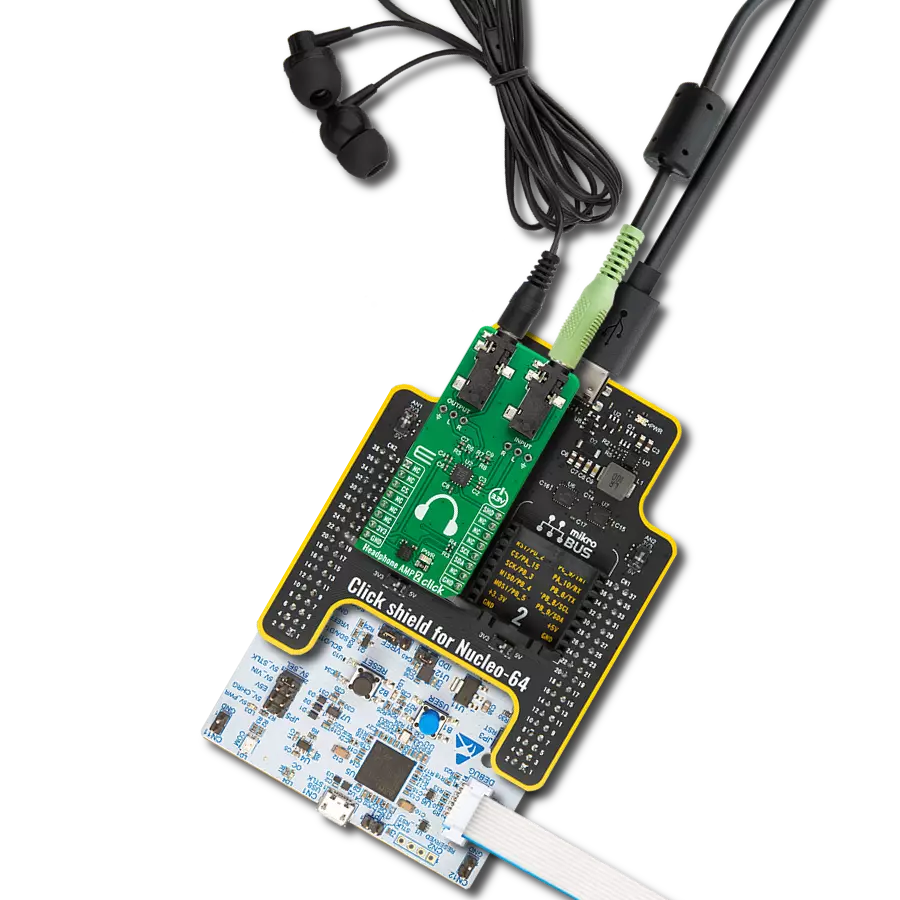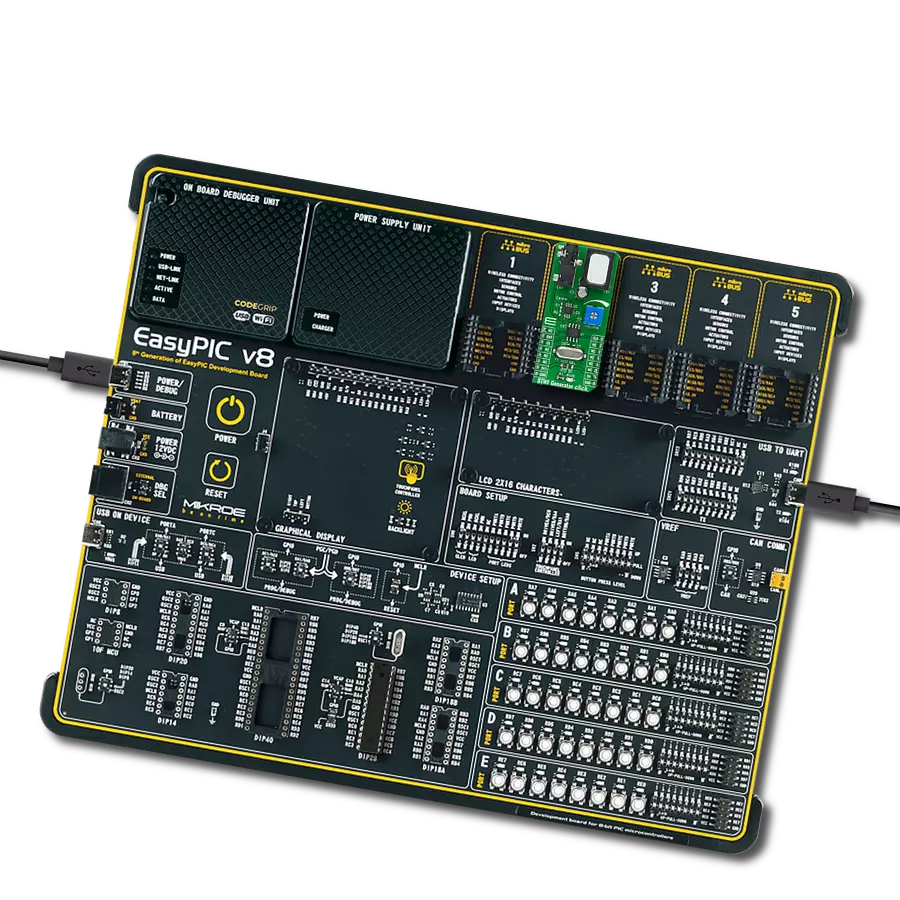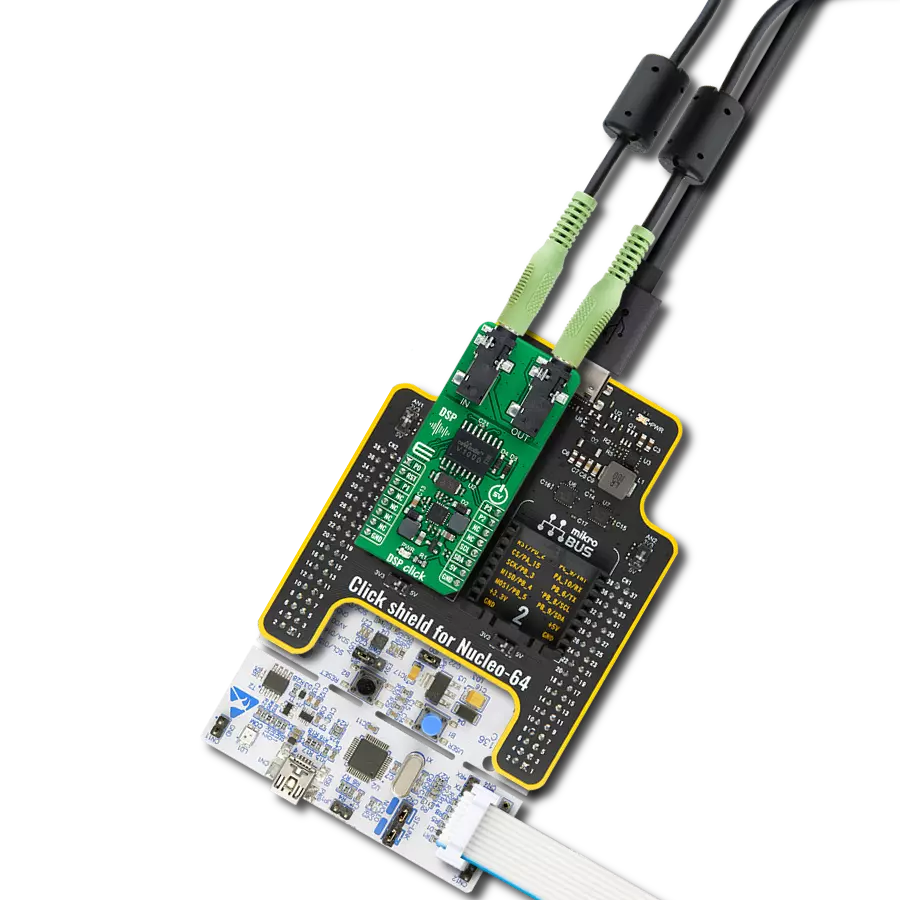Journey into the world of DTMF signal generation, where we uncover the magic that results in the creation of Dual-Tone Multi-Frequency signals vital for mobile communication systems
A
A
Hardware Overview
How does it work?
DTMF Generator Click is based on the HT9200A, a dual-tone multi-frequency decoder from Holtek Semiconductor for mobile communication systems. The HT9200A is an SMD tone generator IC designed for MCU interfaces. It can be instructed by an MCU to generate 16 dual tones and eight single tones from the DTMF pin, and it provides a Serial Mode. The system oscillator of HT9200A consists of an inverter, a bias resistor, and the required load capacitor on a chip. The oscillator function is implemented with a standard 3.579545MHz crystal connected to the X1 and X2 pins of the HT9200A. The operation of the HT9200A is based on GPIO signals fed from the mikroBUS™ to the decoder, DAT, and CLK. There is a connection between the digital codes and the tone output frequency based on the selected desired output frequency. The HT9200A employs a
data input, a 5-bit code, and a synchronous clock to transmit a DTMF signal. Every digit of a transferred number is selected by a series of combinations that consist of 5-bit data. The HT9200A will latch data on the falling edge of the CLK pin and display the output data on its output DTMF pin. Then, via a volume adjustment potentiometer, such a signal is sent to an audio amplifier, the LM386 from Texas Instruments, which represents a mono low-voltage amplifier that can be used in various applications. After the audio amplifier, the desired sound can be detected on the on-board speaker. DTMF Generator Click communicates with MCU using three GPIO pins routed on the CS, RST, and PWM pins of the mikroBUS™ socket labeled CE, DAT, and CLK. CE pin represents the Chip Enable function used to wake up the HT9200A, while DAT
and CLK pins represent data input and synchronous clock input. It also possesses an adjustable potentiometer labeled as VOLUME that adjusts the volume of that signal. It also has a 3.5mm jack output connector that allows the user to use the output DTMF signal in their projects in their way while the signal volume can still be adjusted on the VOLUME potentiometer located on the DTMF Generator Click. This Click board™ can operate with either 3.3V or 5V logic voltage levels selected via the VCC SEL jumper. This way, both 3.3V and 5V capable MCUs can use the communication lines properly. Also, this Click board™ comes equipped with a library containing easy-to-use functions and an example code that can be used as a reference for further development.
Features overview
Development board
PIC18F57Q43 Curiosity Nano evaluation kit is a cutting-edge hardware platform designed to evaluate microcontrollers within the PIC18-Q43 family. Central to its design is the inclusion of the powerful PIC18F57Q43 microcontroller (MCU), offering advanced functionalities and robust performance. Key features of this evaluation kit include a yellow user LED and a responsive
mechanical user switch, providing seamless interaction and testing. The provision for a 32.768kHz crystal footprint ensures precision timing capabilities. With an onboard debugger boasting a green power and status LED, programming and debugging become intuitive and efficient. Further enhancing its utility is the Virtual serial port (CDC) and a debug GPIO channel (DGI
GPIO), offering extensive connectivity options. Powered via USB, this kit boasts an adjustable target voltage feature facilitated by the MIC5353 LDO regulator, ensuring stable operation with an output voltage ranging from 1.8V to 5.1V, with a maximum output current of 500mA, subject to ambient temperature and voltage constraints.
Microcontroller Overview
MCU Card / MCU
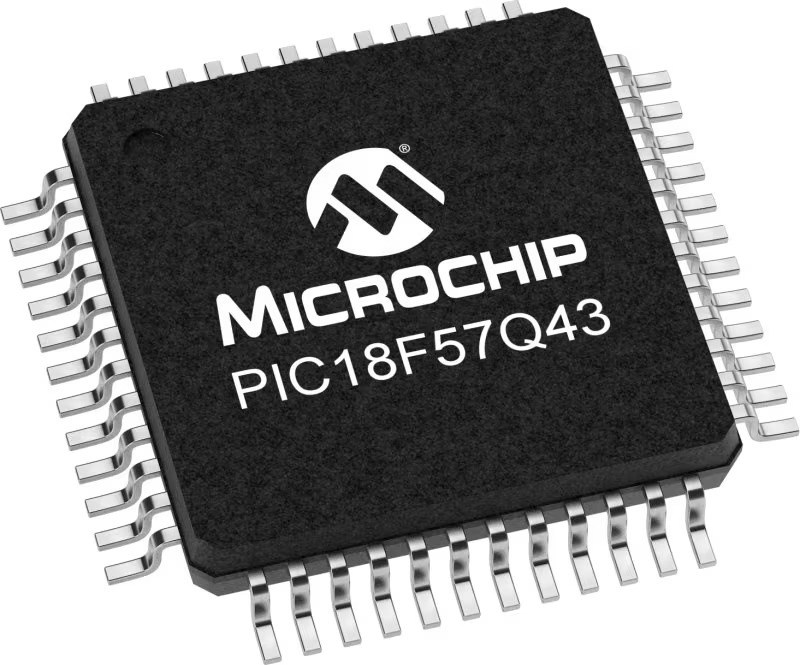
Architecture
PIC
MCU Memory (KB)
128
Silicon Vendor
Microchip
Pin count
48
RAM (Bytes)
8196
You complete me!
Accessories
Curiosity Nano Base for Click boards is a versatile hardware extension platform created to streamline the integration between Curiosity Nano kits and extension boards, tailored explicitly for the mikroBUS™-standardized Click boards and Xplained Pro extension boards. This innovative base board (shield) offers seamless connectivity and expansion possibilities, simplifying experimentation and development. Key features include USB power compatibility from the Curiosity Nano kit, alongside an alternative external power input option for enhanced flexibility. The onboard Li-Ion/LiPo charger and management circuit ensure smooth operation for battery-powered applications, simplifying usage and management. Moreover, the base incorporates a fixed 3.3V PSU dedicated to target and mikroBUS™ power rails, alongside a fixed 5.0V boost converter catering to 5V power rails of mikroBUS™ sockets, providing stable power delivery for various connected devices.
Used MCU Pins
mikroBUS™ mapper
Take a closer look
Click board™ Schematic

Step by step
Project assembly
Track your results in real time
Application Output
1. Application Output - In Debug mode, the 'Application Output' window enables real-time data monitoring, offering direct insight into execution results. Ensure proper data display by configuring the environment correctly using the provided tutorial.

2. UART Terminal - Use the UART Terminal to monitor data transmission via a USB to UART converter, allowing direct communication between the Click board™ and your development system. Configure the baud rate and other serial settings according to your project's requirements to ensure proper functionality. For step-by-step setup instructions, refer to the provided tutorial.

3. Plot Output - The Plot feature offers a powerful way to visualize real-time sensor data, enabling trend analysis, debugging, and comparison of multiple data points. To set it up correctly, follow the provided tutorial, which includes a step-by-step example of using the Plot feature to display Click board™ readings. To use the Plot feature in your code, use the function: plot(*insert_graph_name*, variable_name);. This is a general format, and it is up to the user to replace 'insert_graph_name' with the actual graph name and 'variable_name' with the parameter to be displayed.
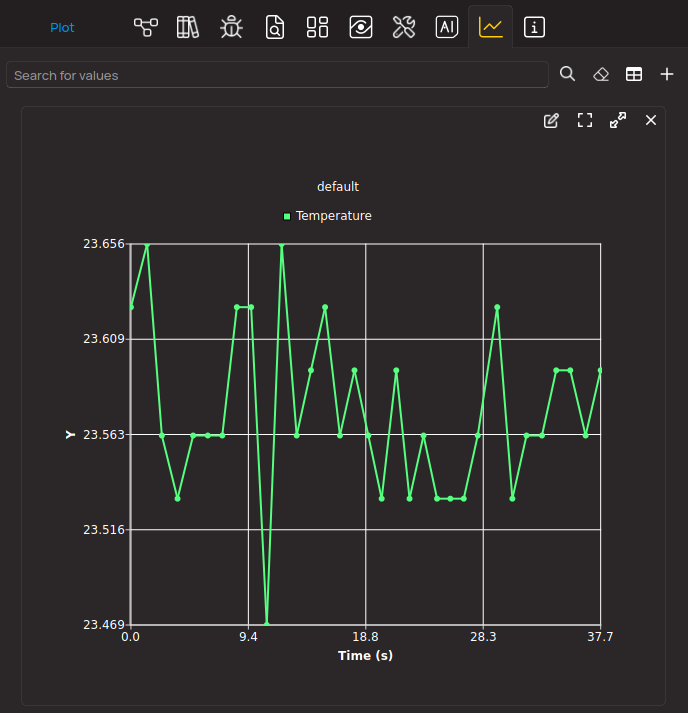
Software Support
Library Description
This library contains API for DTMF Generator Click driver.
Key functions:
dtmfgenerator_set_dat- Set DATA ( RST ) pin state functiondtmfgenerator_power_on- Power ON functiondtmfgenerator_transmit_out_tone- The function transmit duration time of the desired tone
Open Source
Code example
The complete application code and a ready-to-use project are available through the NECTO Studio Package Manager for direct installation in the NECTO Studio. The application code can also be found on the MIKROE GitHub account.
/*!
* @file main.c
* @brief DTMF Generator Click Example.
*
* # Description
* This is an example which demonstrates the use of DTMF Generator Click board.
*
* The demo application is composed of two sections :
*
* ## Application Init
* Initialization driver enables - GPIO,
* run the power-on sequence, also write log.
*
* ## Application Task
* DTMF Generator Click board DTMF generator transmits the signal
* for generating tone for digits :
* "0", "1", "2", "3", "4", "5", "6", "7", "8", "9",
* "A", "B", "C", "D", "*" and "#".
* All data logs write on USB uart changes.
*
* @author Stefan Ilic
*
*/
#include "board.h"
#include "log.h"
#include "dtmfgenerator.h"
static dtmfgenerator_t dtmfgenerator; /**< DTMF Generator Click driver object. */
static log_t logger; /**< Logger object. */
static uint16_t signal_duration = 500;
void application_init ( void ) {
log_cfg_t log_cfg; /**< Logger config object. */
dtmfgenerator_cfg_t dtmfgenerator_cfg; /**< Click config object. */
/**
* Logger initialization.
* Default baud rate: 115200
* Default log level: LOG_LEVEL_DEBUG
* @note If USB_UART_RX and USB_UART_TX
* are defined as HAL_PIN_NC, you will
* need to define them manually for log to work.
* See @b LOG_MAP_USB_UART macro definition for detailed explanation.
*/
LOG_MAP_USB_UART( log_cfg );
log_init( &logger, &log_cfg );
log_info( &logger, " Application Init " );
// Click initialization.
dtmfgenerator_cfg_setup( &dtmfgenerator_cfg );
DTMFGENERATOR_MAP_MIKROBUS( dtmfgenerator_cfg, MIKROBUS_1 );
if ( DIGITAL_OUT_UNSUPPORTED_PIN == dtmfgenerator_init( &dtmfgenerator, &dtmfgenerator_cfg ) ) {
log_error( &logger, " Application Init Error. " );
log_info( &logger, " Please, run program again... " );
for ( ; ; );
}
log_printf( &logger, " Powering on device \r\n" );
log_printf( &logger, "--------------------\r\n" );
dtmfgenerator_power_on( &dtmfgenerator );
Delay_ms ( 1000 );
log_info( &logger, " Application Task " );
}
void application_task ( void ) {
log_printf( &logger, " TONE '0' \r\n");
log_printf( &logger, "---------------\r\n" );
dtmfgenerator_transmit_out_tone( &dtmfgenerator, DTMFGENERATOR_OUT_TONE_0, signal_duration );
dtmfgenerator_transmit_out_tone( &dtmfgenerator, DTMFGENERATOR_OUT_TONE_STOP, signal_duration );
log_printf( &logger, " TONE '1' \r\n");
log_printf( &logger, "---------------\r\n" );
dtmfgenerator_transmit_out_tone( &dtmfgenerator, DTMFGENERATOR_OUT_TONE_1, signal_duration );
dtmfgenerator_transmit_out_tone( &dtmfgenerator, DTMFGENERATOR_OUT_TONE_STOP, signal_duration );
log_printf( &logger, " TONE '2' \r\n");
log_printf( &logger, "---------------\r\n" );
dtmfgenerator_transmit_out_tone( &dtmfgenerator, DTMFGENERATOR_OUT_TONE_2, signal_duration );
dtmfgenerator_transmit_out_tone( &dtmfgenerator, DTMFGENERATOR_OUT_TONE_STOP, signal_duration );
log_printf( &logger, " TONE '3' \r\n");
log_printf( &logger, "---------------\r\n" );
dtmfgenerator_transmit_out_tone( &dtmfgenerator, DTMFGENERATOR_OUT_TONE_3, signal_duration );
dtmfgenerator_transmit_out_tone( &dtmfgenerator, DTMFGENERATOR_OUT_TONE_STOP, signal_duration );
log_printf( &logger, " TONE '4' \r\n");
log_printf( &logger, "---------------\r\n" );
dtmfgenerator_transmit_out_tone( &dtmfgenerator, DTMFGENERATOR_OUT_TONE_4, signal_duration );
dtmfgenerator_transmit_out_tone( &dtmfgenerator, DTMFGENERATOR_OUT_TONE_STOP, signal_duration );
log_printf( &logger, " TONE '5' \r\n");
log_printf( &logger, "---------------\r\n" );
dtmfgenerator_transmit_out_tone( &dtmfgenerator, DTMFGENERATOR_OUT_TONE_5, signal_duration );
dtmfgenerator_transmit_out_tone( &dtmfgenerator, DTMFGENERATOR_OUT_TONE_STOP, signal_duration );
log_printf( &logger, " TONE '6' \r\n");
log_printf( &logger, "---------------\r\n" );
dtmfgenerator_transmit_out_tone( &dtmfgenerator, DTMFGENERATOR_OUT_TONE_6, signal_duration );
dtmfgenerator_transmit_out_tone( &dtmfgenerator, DTMFGENERATOR_OUT_TONE_STOP, signal_duration );
log_printf( &logger, " TONE '7' \r\n");
log_printf( &logger, "---------------\r\n" );
dtmfgenerator_transmit_out_tone( &dtmfgenerator, DTMFGENERATOR_OUT_TONE_7, signal_duration );
dtmfgenerator_transmit_out_tone( &dtmfgenerator, DTMFGENERATOR_OUT_TONE_STOP, signal_duration );
log_printf( &logger, " TONE '8' \r\n");
log_printf( &logger, "---------------\r\n" );
dtmfgenerator_transmit_out_tone( &dtmfgenerator, DTMFGENERATOR_OUT_TONE_8, signal_duration );
dtmfgenerator_transmit_out_tone( &dtmfgenerator, DTMFGENERATOR_OUT_TONE_STOP, signal_duration );
log_printf( &logger, " TONE '9' \r\n");
log_printf( &logger, "---------------\r\n" );
dtmfgenerator_transmit_out_tone( &dtmfgenerator, DTMFGENERATOR_OUT_TONE_9, signal_duration );
dtmfgenerator_transmit_out_tone( &dtmfgenerator, DTMFGENERATOR_OUT_TONE_STOP, signal_duration );
log_printf( &logger, " TONE 'A' \r\n");
log_printf( &logger, "---------------\r\n" );
dtmfgenerator_transmit_out_tone( &dtmfgenerator, DTMFGENERATOR_OUT_TONE_A, signal_duration );
dtmfgenerator_transmit_out_tone( &dtmfgenerator, DTMFGENERATOR_OUT_TONE_STOP, signal_duration );
log_printf( &logger, " TONE 'B' \r\n");
log_printf( &logger, "---------------\r\n" );
dtmfgenerator_transmit_out_tone( &dtmfgenerator, DTMFGENERATOR_OUT_TONE_B, signal_duration );
dtmfgenerator_transmit_out_tone( &dtmfgenerator, DTMFGENERATOR_OUT_TONE_STOP, signal_duration );
log_printf( &logger, " TONE 'C' \r\n");
log_printf( &logger, "---------------\r\n" );
dtmfgenerator_transmit_out_tone( &dtmfgenerator, DTMFGENERATOR_OUT_TONE_C, signal_duration );
dtmfgenerator_transmit_out_tone( &dtmfgenerator, DTMFGENERATOR_OUT_TONE_STOP, signal_duration );
log_printf( &logger, " TONE 'D' \r\n");
log_printf( &logger, "---------------\r\n" );
dtmfgenerator_transmit_out_tone( &dtmfgenerator, DTMFGENERATOR_OUT_TONE_D, signal_duration );
dtmfgenerator_transmit_out_tone( &dtmfgenerator, DTMFGENERATOR_OUT_TONE_STOP, signal_duration );
log_printf( &logger, " TONE '*' \r\n");
log_printf( &logger, "---------------\r\n" );
dtmfgenerator_transmit_out_tone( &dtmfgenerator, DTMFGENERATOR_OUT_TONE_ASTERISK, signal_duration );
dtmfgenerator_transmit_out_tone( &dtmfgenerator, DTMFGENERATOR_OUT_TONE_STOP, signal_duration );
log_printf( &logger, " TONE '#' \r\n");
log_printf( &logger, "---------------\r\n" );
dtmfgenerator_transmit_out_tone( &dtmfgenerator, DTMFGENERATOR_OUT_TONE_HASH, signal_duration );
dtmfgenerator_transmit_out_tone( &dtmfgenerator, DTMFGENERATOR_OUT_TONE_STOP, signal_duration );
}
int main ( void )
{
/* Do not remove this line or clock might not be set correctly. */
#ifdef PREINIT_SUPPORTED
preinit();
#endif
application_init( );
for ( ; ; )
{
application_task( );
}
return 0;
}
// ------------------------------------------------------------------------ END
Additional Support
Resources
Category:Signal Processing





















